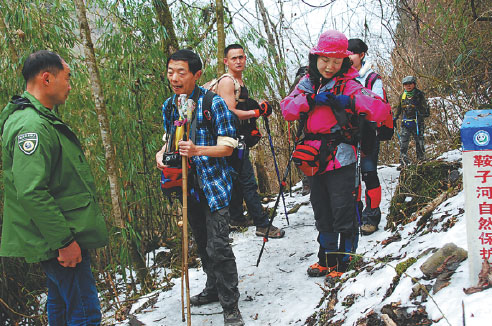Panda 'love corridor' under threat
By Huang Zhiling in Chengdu and Peng Yining in Beijing (China Daily) Updated: 2015-04-13 07:33|
A nature reserve worker (left) tries to persuade tourists not to enter the reserve, as their presence might disturb pandas using the passageway. Wang Lei / for China Daily |
Danger zones
According to data from the State Forestry Administration in February, China's wild pandas are spread among 33 groups, many of which have a population of less than 30. Twenty-four groups, including 223 pandas, are at "considerable" risk of disappearing, while 18 groups have less than 10 pandas and face a "high" risk.
"For small groups, the love corridor is their only chance to find a partner and survive," Hou said. "If the corridor is taken over by people, the pandas will disappear in a few years."
It is not just the wildlife the tourists are affecting. They also leave piles of garbage and potential fire hazards in their wake, according to Liu Yong, another park ranger at Anzihe Nature Reserve.
He said two groups of about 30 hikers in February left plastic bags and empty containers for instant noodles strewn along the forest floor. "We had to clean up all their garbage in the snow and at altitudes of up to 2,000 meters."
Hikers in prohibited areas are also putting their own lives at risk.
In July, four people had to call the police after getting lost in the reserve. A rescue team of more than 10 people, including eight park rangers, searched for nine hours until the group was found at 3 am.
And last month, a 44-year-old woman fell down a slope while hiking with a group of 38 people. She suffered severe injuries to her eyes and lungs, and it took 29 people 22 hours to save her. Rescuers said she had been lucky, as a boulder had prevented her plummeting 40 meters into a valley below.
"We find that many hikers get lost in the woods, or fall or hurt themselves some other way," Liu said. "For the safety of the pandas, the other wild and animals and people, we just can't let tourists in."
Contact the writers at huangzhiling@chinadaily.com.cn and pengyining@chinadaily.com.cn
- Govt encourages people to work 4.5 days a week
- Action to be taken as HIV cases among students rise
- Debate grows over reproductive rights
- Country's first bishop ordained in 3 years
- China builds Tibetan Buddhism academy in Chengdu
- Authorities require reporting of HIV infections at schools
- Typhoon Soudelor kills 14 in East China
- Police crack down on overseas gambling site
- Debate over death penalty for child traffickers goes on
- Beijing to tighten mail security for war anniversary








